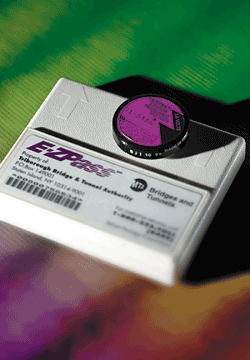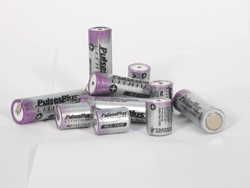Lithium batteries take wireless sensors to extremes
Advanced lithium batteries can power remote wireless sensors for 25+ years, even in harsh environmental conditions
BY SOL JACOBS
Tadiran Batteries
www.tadiran.com
Wireless sensors have become ubiquitous in modern society, found in everything from RFID tags to GPS tracking systems, automatic meter reading (AMR/AMI), mesh networks, system control and data acquisition (SCADA), data loggers, measurement while drilling, oceanographic and environmental measurement, emergency/safety equipment, military and aerospace systems, and other remote sensors. Lithium batteries are predominantly chosen over energy harvesting devices for most of these applications due to lower cost and proven reliability.
The more hostile the environment, the more critical it is to specify the ideal power management solution. This is especially true if the application involves a remote location where battery replacement is difficult or costly. Extreme environmental conditions can also be found in highly accessible locations.
The most common example is the E-ZPass toll tag, which is often subjected to extreme heat, vibration, and rapid temperature cycling, but must work reliably for decades. To achieve exceptionally long life, Ez-Pass devices are powered exclusively by lithium thionyl chloride (LiSOCl2 ) batteries.

Fig. 1: Lithium thionyl chloride (LiSOCl2 ) batteries meet the extreme heat, vibration and rapid temperature cycling needs for toll-tag devices in cars.
LiSOCl2 batteries are also utilized to power tens of millions of wireless automated meter reading (AMR) units in all types of conditions, from artic cold to desert heat. LiSOCl2 batteries are also used in medical RFID tags that must withstand the prolonged heat of autoclave sterilization cycles, as well as data in loggers that must work continuously in the cold chain.
LiSOCl2 chemistry is ideal for use in extreme environments because it offers the highest specific energy (energy per unit weight) and energy density (energy per unit volume) of all existing battery chemistries. One reason for lithium’s high energy density is its large electric potential, which exceeds that of other metals, and which produces the high voltages typical of lithium batteries (2.7 to 3.9 Vdc).
Lithium cells use a nonaqueous electrolyte, which enables certain LiSOCl2 batteries to operate in extreme temperatures (–55° to 125°C), with certain models adaptable to the cold chain (–80°C). Recently, Tadiran LiSOCl2 cells were placed in a chyro chamber and subjected to progressively lower temperatures down to –100˚C and continued to operate as needed.
The advantages of bobbin-type construction
LiSOCl2 batteries are constructed two ways: spiral wound (jelly roll) cells and bobbin-type cells.
Spiral wound LiSOCl2 cells feature an energy density of 800 Wh/I, a temperature range of –55° to 85°C, and a maximum service life of approximately 10 years. While capable of delivering high current pulses, their multiple wound layer design increases surface area, resulting in higher current draw and higher self-discharge than comparable bobbin-type cells, which feature higher energy density (1.420 Wh/I), higher capacity, a wider temperature range (–55° to 125°C), and longer service life due to very low self-discharge (1% to 2% per year).
Adapting to the needs of two-way communications
Back in 1984, bobbin-type LiSOCl2 cells were chosen by Aclara (formerly Hexagram) to power their earliest wireless AMR meter. While many of these older units are currently being replaced, they still remain operational on their original LiSOCl2 batteries even after 28+ years in the field.
Aclara and other AMR meter manufacturers are upgrading newer models to offer “on demand” two-way RF communications, which places greater demand on the battery to deliver the high current pulses required for data transmission. In response, Tadiran developed the PulsesPlus battery, which combines a standard bobbin-type LiSOCl2 battery with a patented hybrid layer capacitor (HLC). This combination allows remote sensors to operate with nil or low background current; a measurement or interrogation mode requiring a few hundred milliamps; a transmission mode that delivers high-current pulse load for a brief period; then returning to a sleep or standby mode to extend battery life.
With PulsesPlus technology, the battery and HLC work in parallel, with the battery supplying long-term low-current power while the HLC stores current pulses up to 15 A, eliminating the voltage drop that normally occurs when a pulsed load is initially drawn. A unique feature of PulsesPlus batteries is that they potentially allow devices to be programmed for low battery status alerts. A 3.6-V system indicates when approximately 95% of battery capacity has been exhausted. A 3.9-V system indicates when 90% of available capacity has been used up.

Fig. 2: PulsePlus battery combines bobbin-type LiSOCl2 battery with a patented hybrid layer capacitor for on-demand two-way RF communications.
Supercapacitors have also been used in conjunction with lithium cells, but their relatively high self-discharge rate can cause the battery to fail early. Likewise, a supercapacitor is made up of two 2.3-V capacitors that need a balancing circuit to ensure service life.
By contrast, the HLC is a single unit that works in the 3.6 to 3.9-V nominal range to avoid the balancing and current leakage problems associated with super capacitors, and has been field proven to deliver high current pulses and a high safety margin.
If moderate current pulses are required, a new battery technology has just been developed, Tadiran Rapid Response TRR series batteries. The TRR series does not require the use of an HLC but is still capable of delivering high capacity and high energy density without voltage or power delay.
When a standard LiSOCl2 battery is first subjected to load (especially at cold temperatures or when the battery is nearing the end of its operating life) voltage can drop temporarily and then return to its nominal value. TRR series batteries were designed to virtually eliminate this voltage drop as well as voltage drop under pulse (or transient minimum voltage level). The final result is zero delay during the voltage response. TRR series batteries use available capacity very efficiently, thus extending the operating life of the battery by up to 15% under certain conditions, especially in extremely hot or cold temperatures.
Choosing the right power management solution
Every application is unique in terms of its power and performance requirements, demanding a thorough understanding of battery selection criteria such as voltage, capacity, size and weight, expected service life, temperature and/or environmental issues, and cost. Additional design criteria may include requirements for high current pulses, high discharge rate, safety factors, and storage requirements.
Design engineers need to be aware that competing batteries using the same chemistry can exhibit varying self-discharge rates, which is governed by the chemical composition of the electrolyte, the manufacturing process used, as well as mechanical and environmental considerations. Self-discharge can also be negatively impacted by high levels of impurities in the electrolyte. Exposure to high temperature can also have a very negative effect on both self-discharge and voltage.
Experienced battery manufacturers continually modify cell designs and use proprietary techniques and materials to enhance battery power and performance. For example, an experienced battery manufacturer can effectively control impedance by blending in special additives with the electrolyte.
To differentiate batteries of superior quality and reliability, as part of the specifying process it is important to demand customer testimonials along with fully documented and verified test results for battery pulse, low-temperature pulses, discharge, repeatability, and product safety. Conducting thorough due diligence will help ensure that your remote wireless sensor delivers decades of trouble-free performance, even in extreme environments. ■
Advertisement
Learn more about Tadiran





